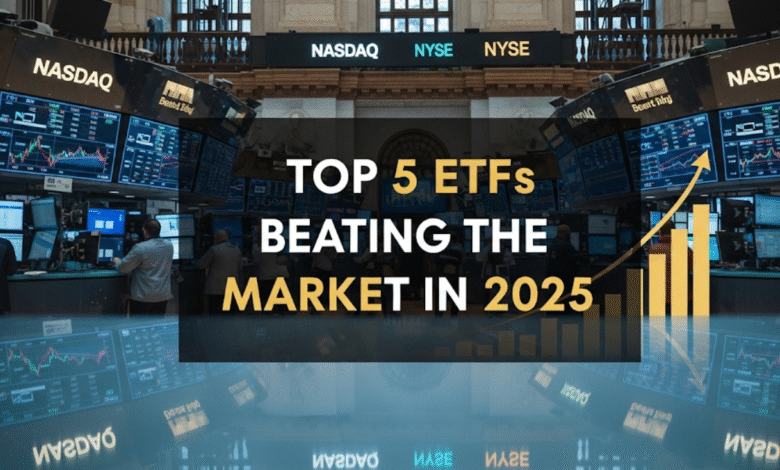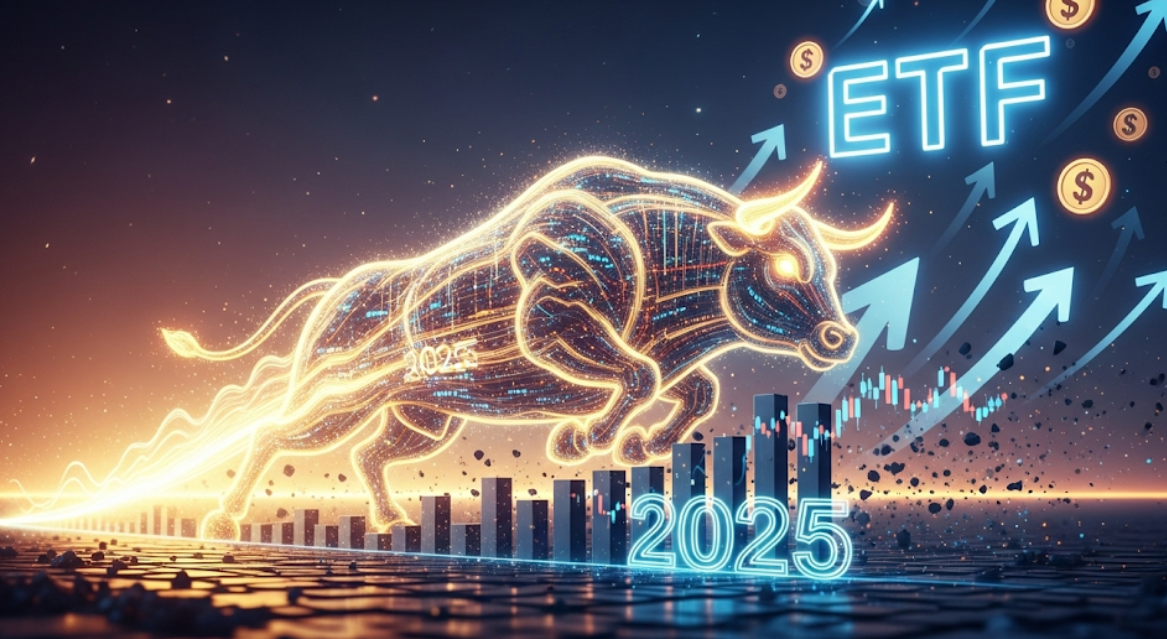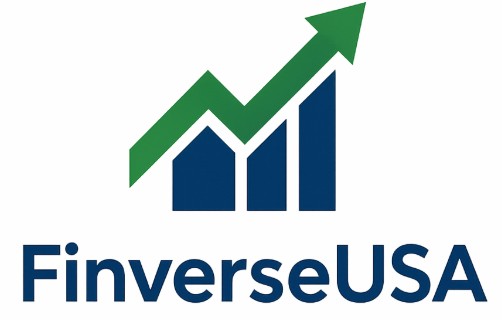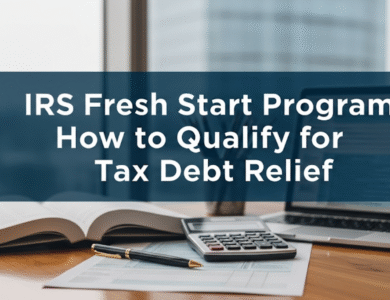
Regrettably, there’s no way for you to play along and test your capital markets instincts – at least, not yet. Your chance to beat the market comes in the form of 5 exchange-traded funds.
The 2025 stock market has brought some surprises, with exchange-traded funds (ETFs) leaving ordinary investors in the dust. The S&P 500 has been doing well but some of these ETFs have been destroying them and giving smart investors unreal returns.
If you want to increase your investment returns without picking individual stocks, these market-beating ETFs may be just what your portfolio needs. That was more than what ETFs gathered during the entire first half of 2024. This suggests that more investors today are choosing to use ETFs as part of their investment plan than ever before.
In this piece, we will analyze the Top 5 ETFs that are outperforming the market this year and what makes them stand out against the rest.
How ETFs Rule the Investing World in 2025
First, a little bit of explanation about why ETFs have become such a potent investing force before we get to our top picks. Index funds can make you wealthy without the work, time and risk of investing in individual companies.
ETFs offer several key advantages:
Instant Diversification: Instead of buying dozens of individual stocks, a single ETF can provide exposure to hundreds or thousands of companies.
Lower Costs: The vast majority of ETFs charge significantly less than actively managed mutual funds so you’re likely to keep more money in your pocket.
Flexibility: You can trade ETFs just like stocks, buying and selling them during market hours.
Professional Management: All ETFs—even passive ones—are professionally managed for accuracy in tracking their underlying benchmarks.
How We Selected These Market-Beating ETFs
We didn’t pull these ETFs out of our… hats. Our selection process focused on:
- Outperformance of major market indexes with the market rotation to 2025
- Expense ratios that are reasonable and don’t eat into your returns
- Strong enough liquidity to trade easily
- Sound underpinnings that indicate a strong future
- Various industries and styles to give you a wider range
Now, let’s see the ETFs that have been wrecking the market this year.
1. VanEck Semiconductor ETF (SMH) – The Tech King Powerhouse
Why It’s Beating the Market
The semiconductor industry has been on fire in 2025, and the VanEck Semiconductor ETF has been playing off of this trend just right. The top-performing ETF during the past 10 years is VanEck Semiconductor ETF (SMH). If you had invested $10,000 in SMH 10 years ago, that investment would be worth over $125,000 today.
Key Holdings: This ETF holds big players such as NVIDIA, AMD, Intel and Taiwan Semiconductor Manufacturing Company.
Performance Driver: The AI revolution and need for the advanced chips that fuel it have propelled semiconductor stocks to the stratosphere.
Expense Ratio: 0.35% — reasonable for a niche sector ETF
What Makes SMH Special
SMH isn’t just a play on the semiconductor industry; it is direct exposure to the companies which are actually producing the chips that power our digital world. From smartphones to electric vehicles to data centers, semiconductors are ubiquitous and this ETF will tap into this growth.
Risk Level: High — industry-specific ETFs can be very volatile
Best For: Tech believers with a long-term horizon who don’t mind some bumps in the road
Also Check – Best Dividend Stocks for Long-Term Wealth
2. Adaptiv Select ETF (ADAP) – The Active Management Winner
The Numbers Speak for Themselves
The best-performing ETF of July was the $142.4 million Adaptiv Select ETF, which rose 8.49%. For the month, the actively managed Adaptive ETF outperformed a 1.36% rise on average among funds in Morningstar’s mid-cap blend category. The fund is up 29.81% over the past 12 months (vs 6.60% for the category), landing it in the first percentile of the group over that span.
Style: Actively managed, so professional fund managers choose the stocks
Focus: Mid-caps with growth potential
Expense Ratio: More expensive than passive ETFs but the performance justifies the cost
Why Active Is Working Here
Whereas most ETFs follow an index, ADAP’s managers make active decisions about what to buy and sell. That flexibility has certainly paid off handsomely in market conditions that have changed in 2025.
Performance Highlights:
- 8.49% gain in July alone
- 29.81% increase over the last year
- Consistently beats its benchmark
Best For: Investors who want professional stock selection but like ETF tactics over mutual funds
3. iShares Semiconductor ETF (SOXX) – SMH’s Close Rival
Double the Semiconductor Success
Next up was the iShares Semiconductor ETF (SOXX); a $10,000 investment in SOXX in 2015 would have turned into more than $90K.
So, while SMH is the star of the show, SOXX has nevertheless produced tremendous returns for investors looking to allocate here.
Key Differences from SMH:
- Slightly different stock weightings
- Lower expense ratio at 0.43%
- Heavy on US chipmakers
Performance Comparison Table
| ETF | 10-Yr Return | Expense Ratio | Top Holding |
|---|---|---|---|
| SMH | 1,150%+ | 0.35% | NVIDIA |
| SOXX | 800%+ | 0.43% | NVIDIA |
Why SOXX over SMH: Some investors like SOXX for its slightly more balanced approach to investing in the semiconductor space.
4. EURO STOXX Banks ETF – European Banking Powerhouse
Record-Breaking Performance
Meanwhile the highest performing index at 68.19% is currently the EURO STOXX® Banks 30-15.
European banks have been on fire this year, with this ETF jumping almost 70% so far this year.
What’s Driving This Success:
- Higher European interest rates aid bank profits
- Economic recovery in the eurozone
- Healthy demand for loans from businesses and consumers
Key Holdings and Strategy
This ETF targets the 30 largest and most liquid banks in the eurozone. It’s a bet on both the recovery of the European economy and the ability of the banking sector to capitalize on higher interest rates.
Currency Considerations: Given this ETF’s exposure to European stocks, movements in the euro/dollar exchange rate may have an impact on returns for U.S. investors.
Risk Level: Moderate to High (banking can be a cyclical industry)
5. Vanguard S&P 500 ETF (VOO) – The No-Nonsense Market Beater
Sometimes Simple Is Best
One of the biggest and most widely held (it was the largest AUM ETF in August 2025), is the Vanguard S&P 500 ETF. The ETF’s size and low cost give it heft that makes it an appealing choice if you want exposure to the broader market.
Less sexy than sector-specific ETFs, VOO has quietly been besting many active managers and delivering ample returns in 2025.
Why VOO Makes the List:
- Ultra-low expense ratio at 0.03%
- Tracks the S&P 500, Wall Street’s most important stock index
- Massive size provides excellent liquidity
- Always beats most actively managed funds
The Power of Low Costs
VOO’s minuscule expense ratio means that 99.97% of your returns remain in your pocket rather than going toward the operating costs of the fund. Over time, that cost advantage compounds into significant value.
Ideal For: Novice investors, buy-and-hold types, and those who want broad market exposure
How to Invest in ETFs in 2025
Dollar-Cost Averaging
Do not use a lump sum to invest, instead make your investment with a small amount of your money each time. That can help ameliorate the hurt from market swings and put you in better shape for long-term returns.
Sector Rotation
Our list consists of ETFs representing various sectors and regions. Smart investors rotate their money between sectors as the cycle turns and the market dictates.
Core-Satellite Approach
You can use a “core and satellite” framework, with a broad market ETF (say, VOO) as your “core” position (making up perhaps 60-80% of your portfolio) and pick some satellite ETFs like SMH or SOXX for additional growth potential.
Also Read – Top Mutual Funds That Beat Inflation in 2025
Risk Management: What You Need to Know
Concentration Risk
Sector-related ETFs such as SMH and SOXX are highly focused in a single area of industry. If the semiconductors take a hit, these ETFs are likely to fall — a lot.
Geographic Risk
The European banking ETF can subject you to risks in the economy and politics of Europe that US-focused ETFs will not.
Market Risk
The best ETFs can lose money when the stock market is in a downturn. Never invest money you can’t afford to lose.
Performance Comparison: 2025 Year-to-Date
| ETF | YTD Return* | Sector | Risk Level |
|---|---|---|---|
| EURO STOXX Banks | 68% | European Banking | High |
| ADAP | 30% | Mid-Cap Blend | Moderate-High |
| SMH | 25% | Semiconductors | High |
| SOXX | 23% | Semiconductors | High |
| VOO | 15% | Broad Market | Moderate |
*Estimates based on available data as of August 2025
Tax Considerations for ETF Investors
Tax Efficiency
ETFs tend to be more tax-efficient relative to mutual funds, because of their unique structure. They create fewer taxable events, so more of your returns remain in your wallet.
Capital Gains
When you sell ETF shares you have made a profit on, you owe capital gains. If you hold for more than a year, you qualify for lower long-term capital gains rates.
Dividend Taxes
A lot of ETFs pay dividends, generally the qualified variety that you get with individual stocks.

Constructing Your ETF Portfolio: A Step-by-Step Guide
Step 1: Identify Your Risk Tolerance
Do you want to take on the volatility that comes with sector-specific ETFs, or the stability of broad market funds?
Step 2: Determine Your Asset Allocation
A common approach might be:
- 60% broad market ETF (such as VOO)
- 20% sector ETFs (SMH or SOXX for example)
- 15% international exposure
- 5% alternative investments
Step 3: Choose Your Brokerage
Seek out brokers that offer commission-free ETF trading and strong research tools.
Step 4: Start Investing
Start with your core holdings and then gradually add satellite positions as you become more comfortable.
What to Watch For in the Rest of 2025
Economic Indicators
Keep an eye on:
- Federal Reserve interest rate decisions
- Inflation trends
- GDP growth rates
- Employment data
Sector-Specific Catalysts
For Tech ETFs: AI progress, chip demand and regulation changes
For Banking ETFs: Interest rates and economic trends in Europe
For Broad Market ETFs: Corporate earnings and general economic well-being
Common Mistakes to Avoid
Chasing Performance
A good year does not ensure future success simply because an ETF performed well. Always keep the fundamentals in mind when analyzing performance.
Over-Diversification
Although diversification can be good, having too many similar ETFs can dilute your returns with only minor risk reduction.
Ignoring Fees
Small differences in expense ratios can add up to thousands of dollars over time. Always compare fees before investing.
Market Timing
Trying to time the market doesn’t work. Steady investing typically fares better than trying to time the market perfectly.
Looking Beyond 2025: Long-Term Considerations
Sustainable Trends
Some of the trends fueling 2025’s best ETFs (such as AI and semiconductor demand) might persist for years. Others might be more cyclical.
Rebalancing Strategy
You may want to periodically rebalance your portfolio to keep it in line with your target asset allocation.
Staying Informed
Markets evolve and so must your investment strategy. Monitor economic trends and how they may affect your ETF holdings.
Frequently Asked Questions
What causes an ETF to “beat” the market?
For an ETF to beat the market means to outperform a broad market index such as the S&P 500. This usually involves offering better percentage gains over a certain period of time when controlled for risk.
Are higher performing ETFs always better?
Not necessarily. High performance often comes with increased risk. Which ETF is best for you will depend on your risk tolerance, investment timeline and overall portfolio strategy.
How much should market-beating ETFs form part of your investment?
The general recommendation from the majority of financial experts is to have no more than 10-20% of your overall holdings in high-risk, high-reward investments. Most of the money should be in steadier, more diversified investments.
Can these ETFs maintain their strong performance?
Past performance is no guarantee of future results. Some trends (like the rise of AI) may persist, but market conditions aren’t constant, and yesterday’s leaders can be tomorrow’s laggards.
What is the minimum needed to begin investing in these ETFs?
You can usually buy fractional shares on most brokerages, so you can start investing with as little as $1-10. But $100-500 could be more realistic to build a significant position.
Should I buy all five of these ETFs?
Not necessarily. SMH and SOXX are highly overlapping due to both being semiconductor ETFs. Pick one based on your portfolio requirements, and avoid duplicating if not required.
How often should I monitor my ETF’s performance?
Although it’s normal to want to track performance, if you check too often you may be susceptible to emotional decision-making. Long-term investors generally only need monthly or quarterly check-ins.
What if interest rates shift in a big way?
Interest rate fluctuations do not affect different sectors equally. Banking ETFs could benefit from higher rates, while ETFs focused on growth technology could suffer. Diversification helps manage this risk.
Final Thoughts: Your Next Steps
The ETFs we’ve included as our favorites are the best performing ones from 2025, though investing success means far more than picking winners. It takes discipline, patience and a clear understanding of your financial goals.
Whether it’s the tremendous upward potential of semiconductor ETFs, the solid, dependable broad market funds, or the niche opportunities in European banking that attract you, the trick is to just get started and stay the course, investing steadily.
So far this year, precious metals and foreign stocks have been among the winning strategies. This is a reminder that diversification among various asset classes and geographic regions is still a winning approach.
The investment marketplace for ETFs has never been so open to individual investors to get access to professional-caliber investment strategies. With the perfect mix of research, patience and savvy risk management, these market-beating ETFs could be the answer to achieving your financial dreams sooner than you ever thought possible.
And don’t forget: The best investment plan of all is the one that you can stick with in both good times and bad. Begin with what you know, learn as you go, and always consider your long-term financial goals.
Check This – How to Start Investing With Just $100




